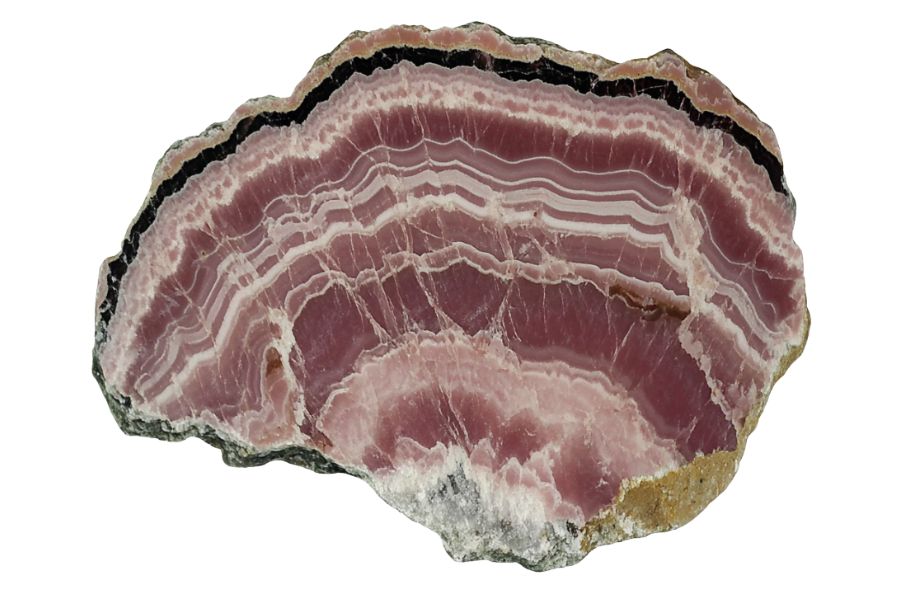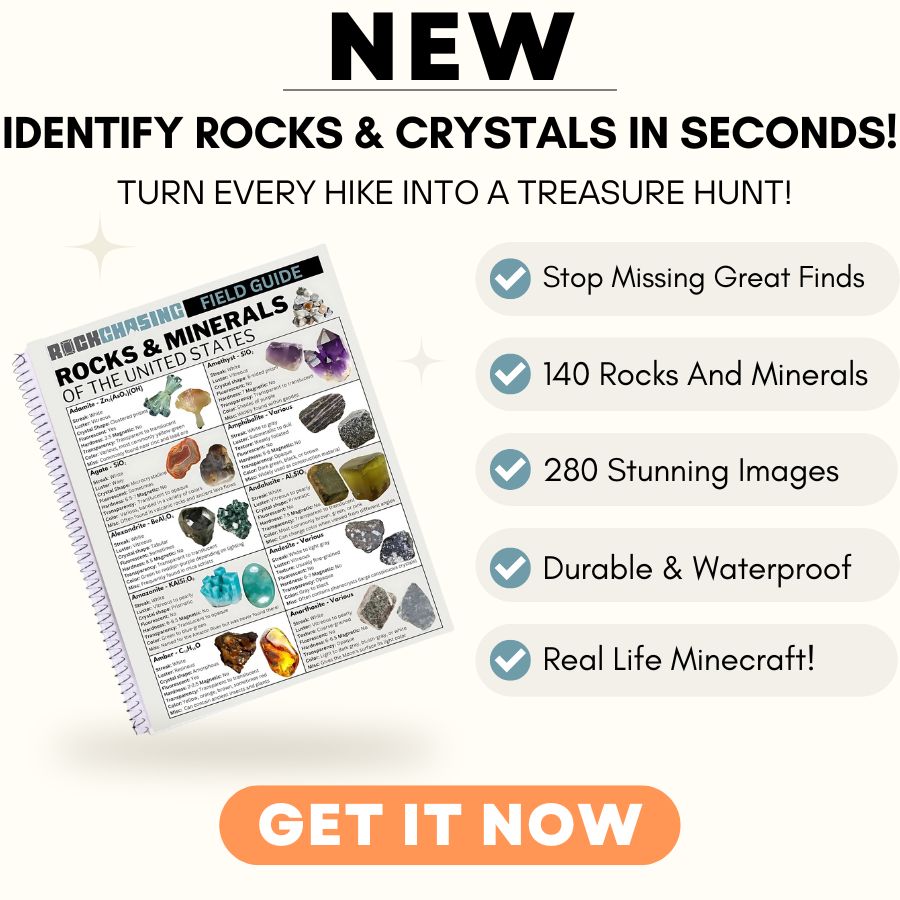New Jersey hides some cool rocks beneath its soil. One of these rocks is rhodochrosite, a pink mineral that rock lovers enjoy finding. This bright stone stands out among the usual gray and brown rocks you might see on a normal hike.
Finding rhodochrosite takes patience and a bit of luck. You need to know where to look since it doesn’t show up everywhere. Some spots in New Jersey have more of this pink stone than others. The right area can make all the difference in your search.
We’ll help you find the best New Jersey areas for rhodochrosite hunting. Each place has its own story and special features that make it good for finding these pink treasures.
How Rhodochrosite Forms Here
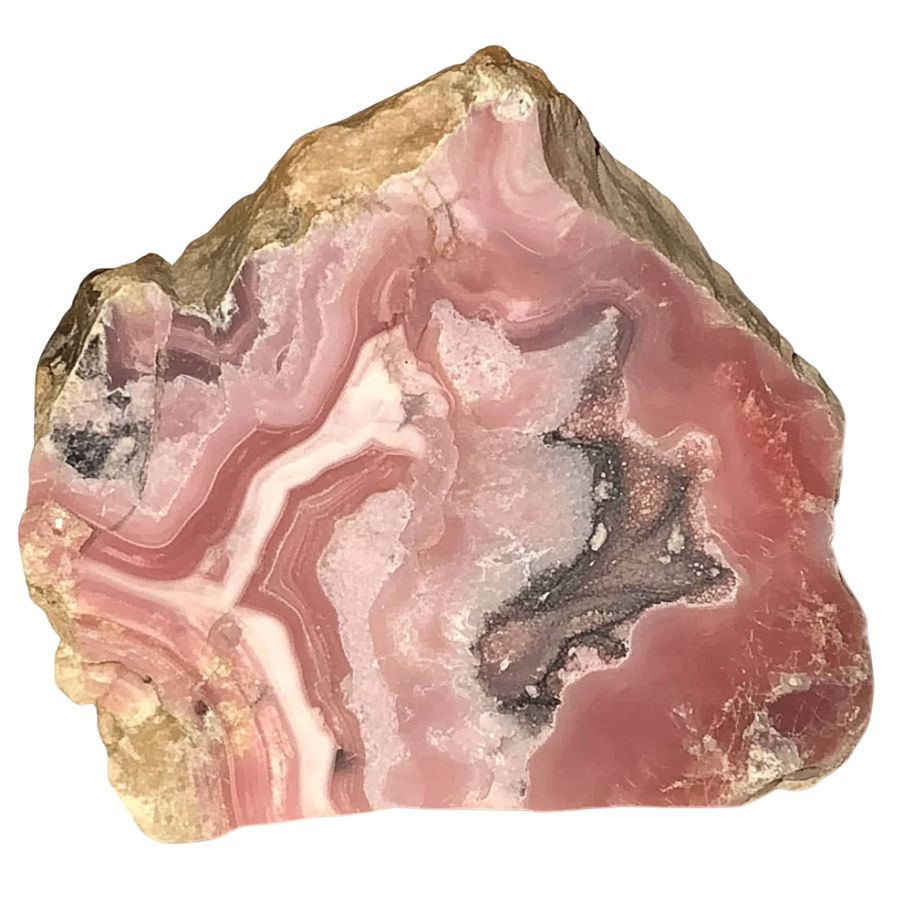
Rhodochrosite forms from manganese-rich waters seeping through cracks in rocks. When these mineral-heavy solutions mix with carbonate materials (like limestone), the magic happens!
Over time, as temperatures and pressures change deep underground, the manganese and carbonate ions come together and slowly crystallize. Sometimes, it forms in beautiful stalactites in empty spaces in rocks, while other times it shows up in hydrothermal veins alongside other minerals.
The most stunning specimens often form when the conditions are just right (not too hot, not too cold) letting the crystals grow slowly into those gorgeous pink rhombohedral shapes we love so much.
Types of Rhodochrosite
Rhodochrosite occurs in several distinct varieties. From delicate pink bands to deep crimson crystals, these variations showcase the diverse beauty of this remarkable mineral.
Pink Rhodochrosite
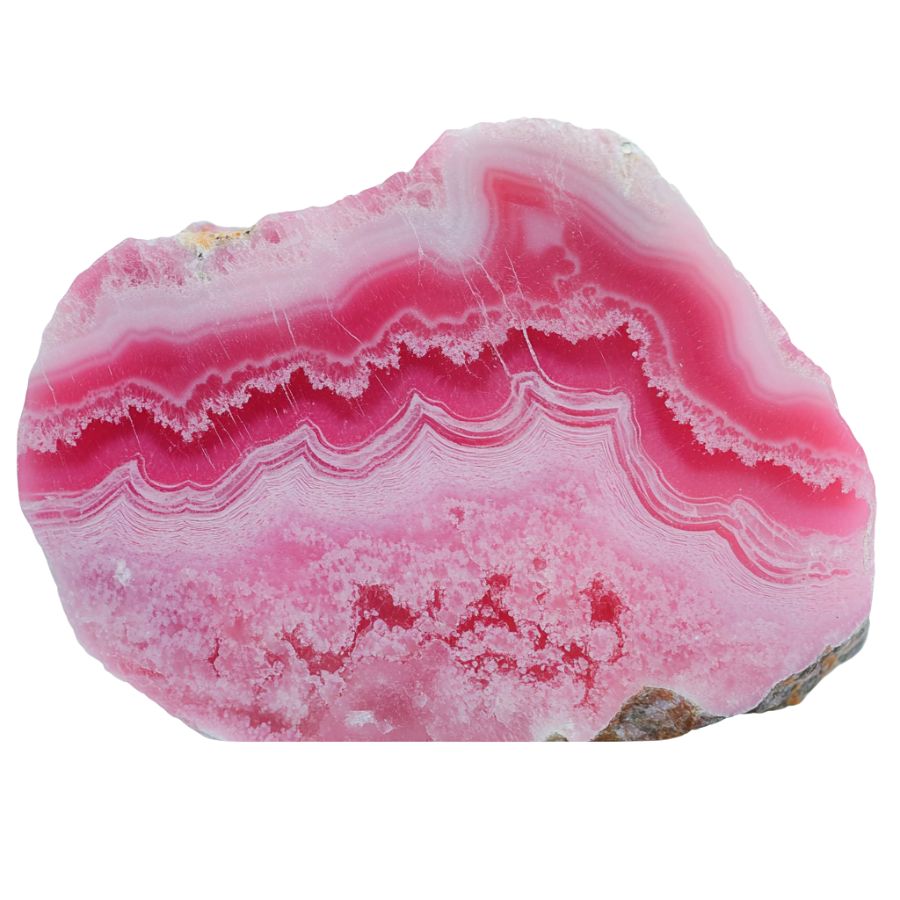
Pink Rhodochrosite displays delicate pink shades that range from soft pastel to deep rose pink. The stone features beautiful banding patterns that create swirling designs throughout its surface.
The translucent to semi-translucent nature of Pink Rhodochrosite adds to its visual appeal. This stone has a special trigonal crystal system that sometimes produces rare transparent crystals.
Fine specimens with clear, transparent crystals are particularly valuable. The best examples show sharp color zones and distinct banding patterns. Stone’s intricate patterns often resemble landscapes or abstract art.
Red Rhodochrosite
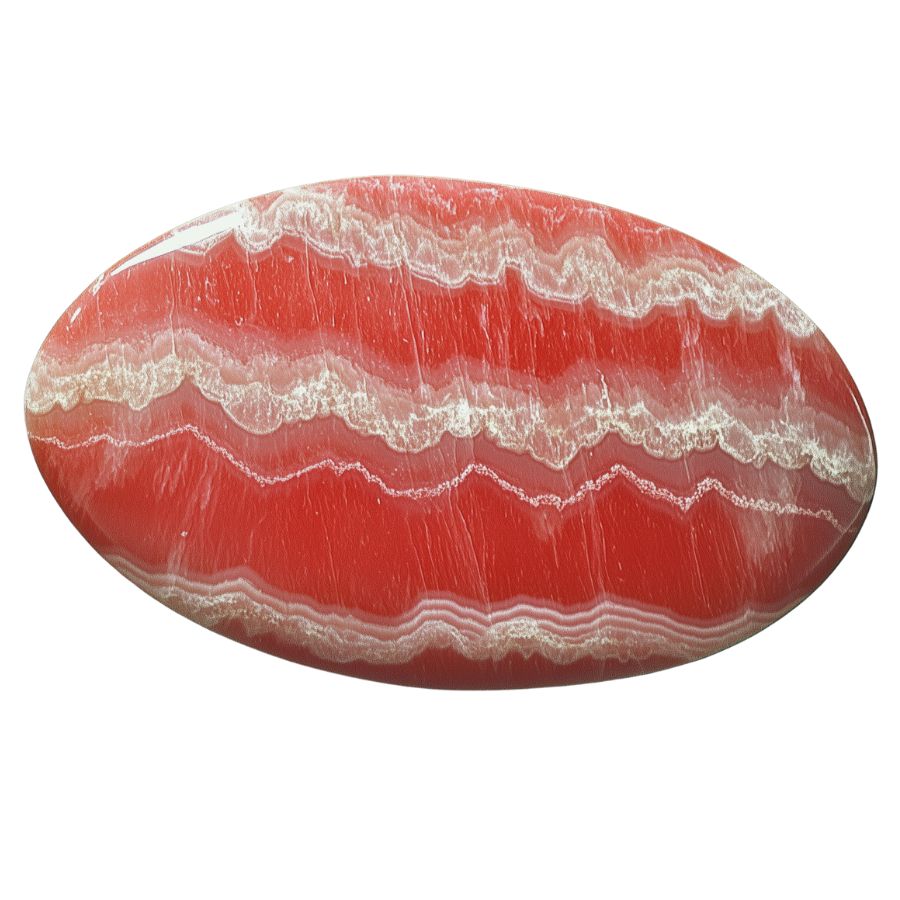
Red Rhodochrosite stands out with its bold, vibrant colors that range from bright red to deep crimson. Its intense red coloring comes from its high manganese content.
This variety can form in interesting shapes, including rhombohedral crystals and stalactite formations. When cut and polished, these formations reveal stunning internal patterns.
The crystal structure of Red Rhodochrosite allows it to form in large, well-defined specimens. These pieces often show sharp color transitions and clear crystal faces. The surface has a bright, glass-like shine when polished.
Some specimens feature dramatic color zoning, where deeper reds blend into lighter shades. This natural gradient effect makes each piece distinct and visually interesting.
Trapiche-like Rhodochrosite
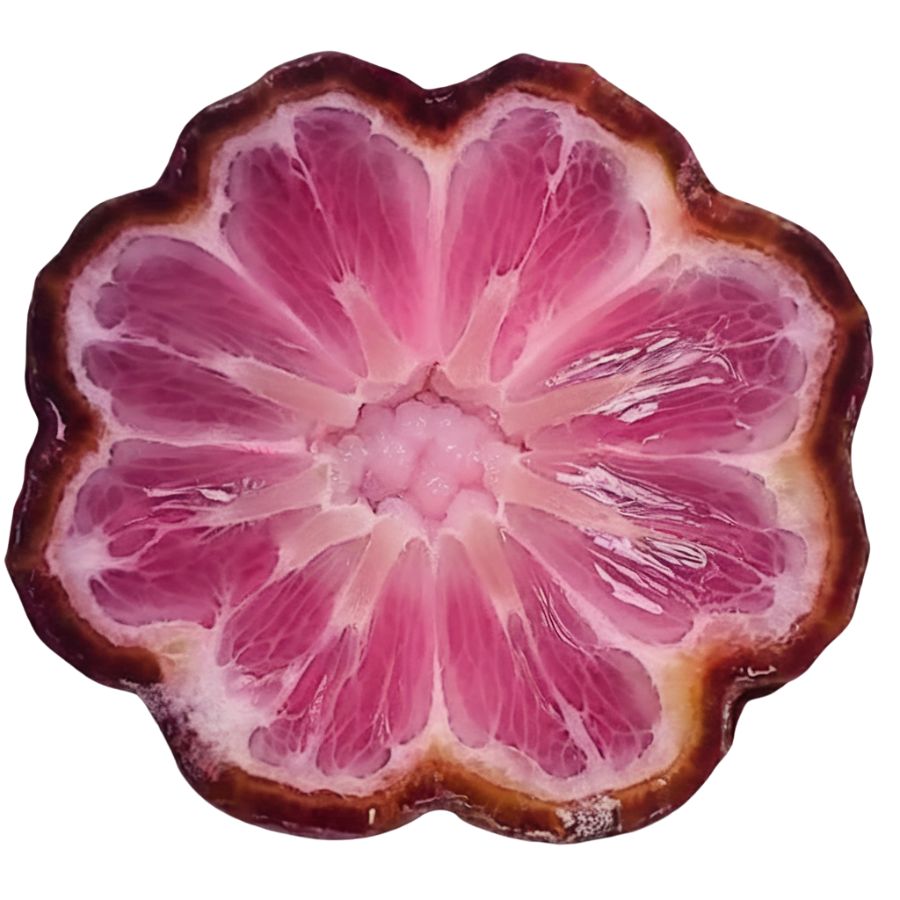
Trapiche-like Rhodochrosite showcases a remarkable star or flower-like pattern that makes it truly special. This pattern forms when crystals grow in a specific way, creating symmetrical rays that extend from the center. The result looks like a wheel with spokes or a blooming flower.
The formation process creates distinct sections within the crystal, each with its own character. These sections join at the center point, creating a natural geometric design.
When the stone is cut perpendicular to its main growth axis, its visual effect is enhanced. This orientation reveals the full beauty of the pattern and shows how the crystal sections fit together perfectly.
South African Rhodochrosite
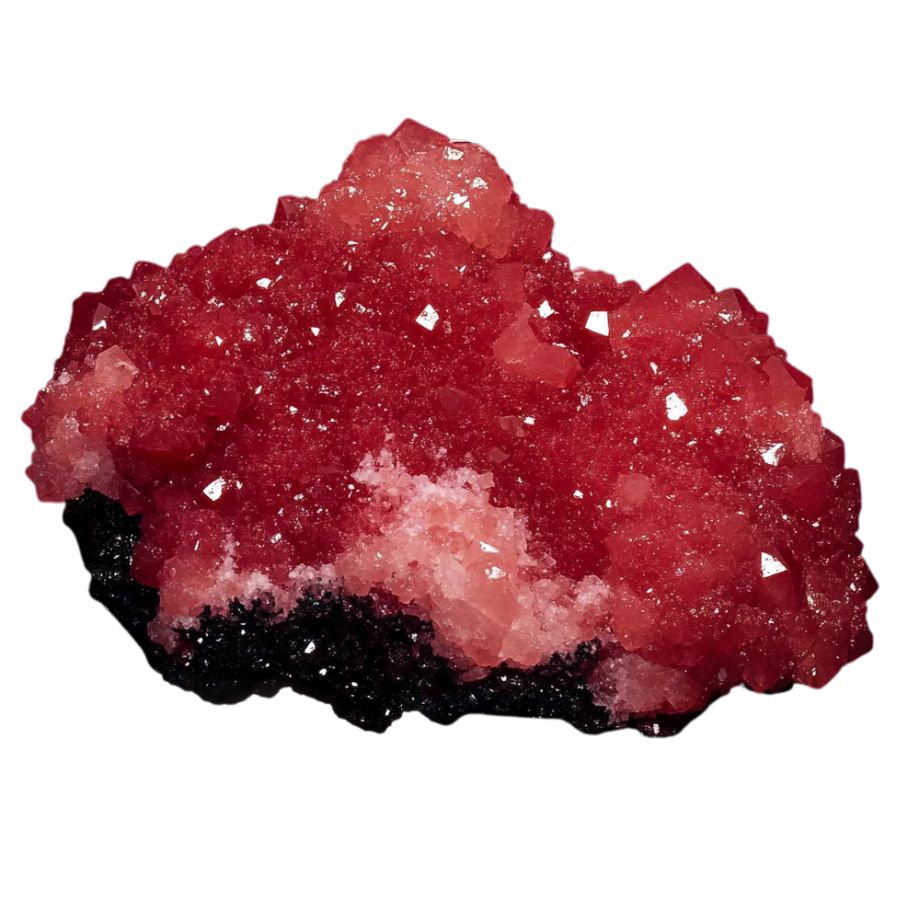
South African Rhodochrosite is known for its deep, rich blood-red color. This intense coloring sets it apart from other varieties. The stone often shows excellent clarity and depth of color which makes it particularly striking.
The internal structure of this variety creates interesting optical effects. When light passes through the stone, it can create a subtle glow that enhances its natural beauty. The crystal structure allows for excellent polish, bringing out the stone’s natural luster.
Many specimens show distinctive growth patterns that form during crystallization. These patterns can create interesting visual effects, from subtle color variations to dramatic geometric designs. The combination of deep color and natural patterning makes each piece unique.
Argentine Rhodochrosite
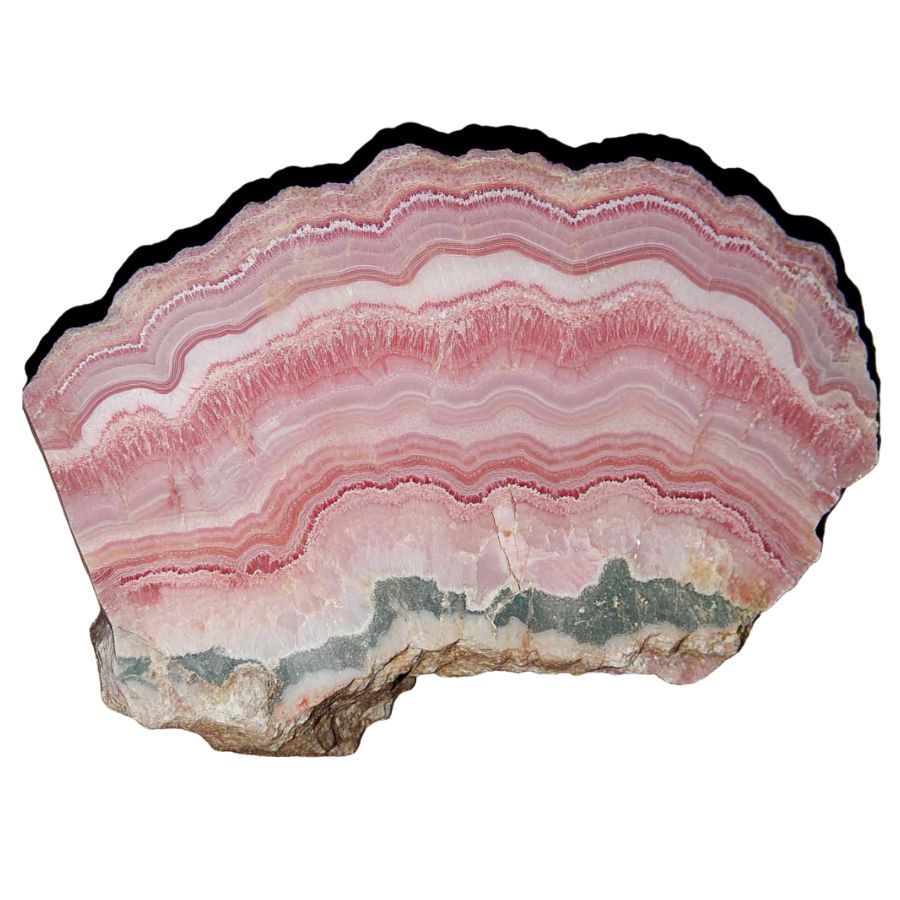
Natural bands of pink and white create stunning patterns across this remarkable stone. Delicate layering resembles fine marble artwork, making each piece unique. The colors shift between pale pink and deep red tones.
Historic significance adds to its charm as the “Inca Rose.” Ancient civilizations treasured these stones for their exceptional beauty. Many specimens show perfect crystal formations that catch and reflect light beautifully.
Exceptional purity sets Argentine specimens apart from others. Crystal formations often grow in perfect rhombohedral shapes. Traditional cutting methods reveal intricate internal patterns that collectors prize.
Colorado Red Rhodochrosite
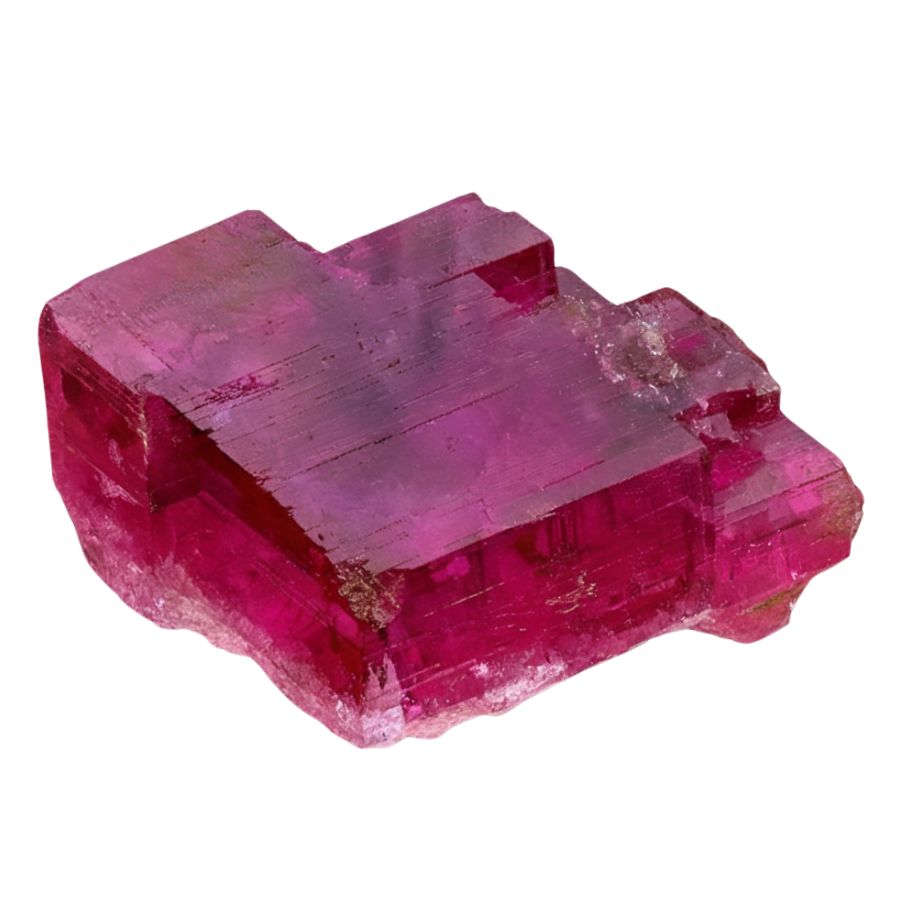
Brilliant rose-red colors distinguish this remarkable variety. Transparent specimens showcase exceptional clarity and fire. Natural light brings out deep crimson undertones that seem to glow from within.
Outstanding crystallization creates sharp, well-defined faces. Remarkable internal structures form during slow growth periods.
Superior brilliance makes these stones stand out in collections. Natural light reveals complex internal reflections. Fresh specimens maintain their vivid coloring over time. Special cutting techniques enhance the stone’s natural beauty.
Banded Rhodochrosite
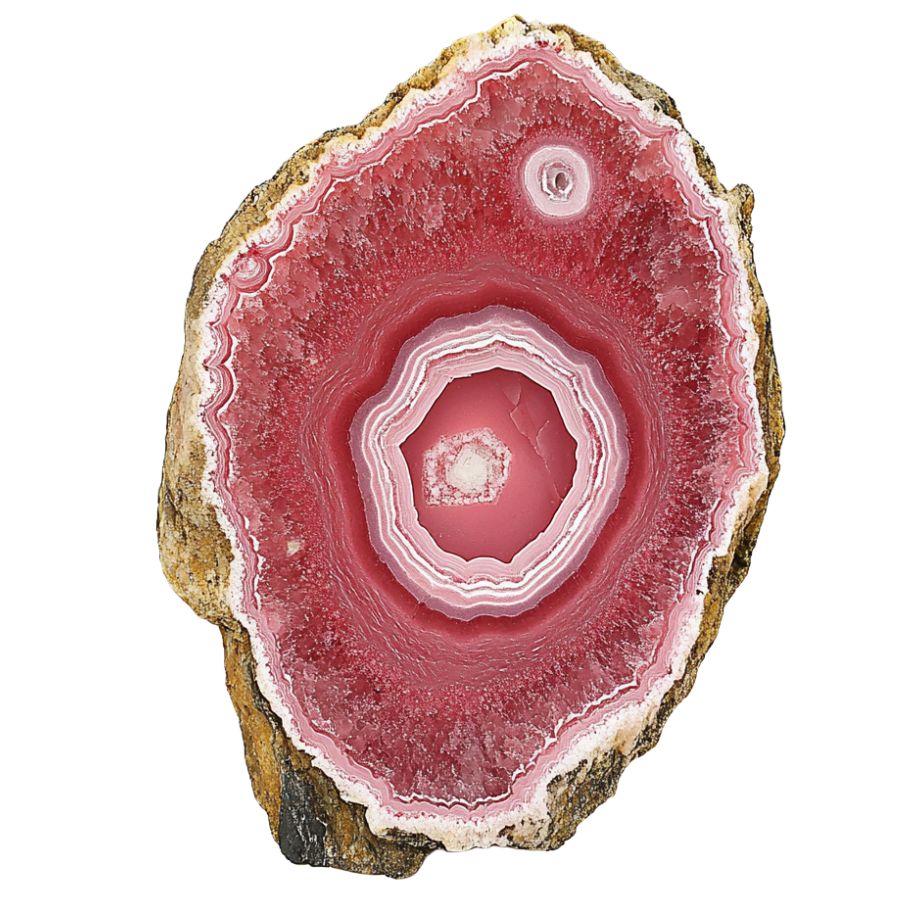
Concentric circles create fascinating patterns throughout this stone. Dramatic bands alternate between light and dark pink shades. Nature’s artistry reveals itself in each cross-section.
Perfect specimens form when mineral-rich water drips slowly over time. Natural processes create stalactite formations with distinct ring patterns.
Multiple layers build up over time to create unique patterns. Natural variation ensures no two pieces look exactly alike. Perfect cross-sections show complete circular patterns.
Peruvian Rhodochrosite
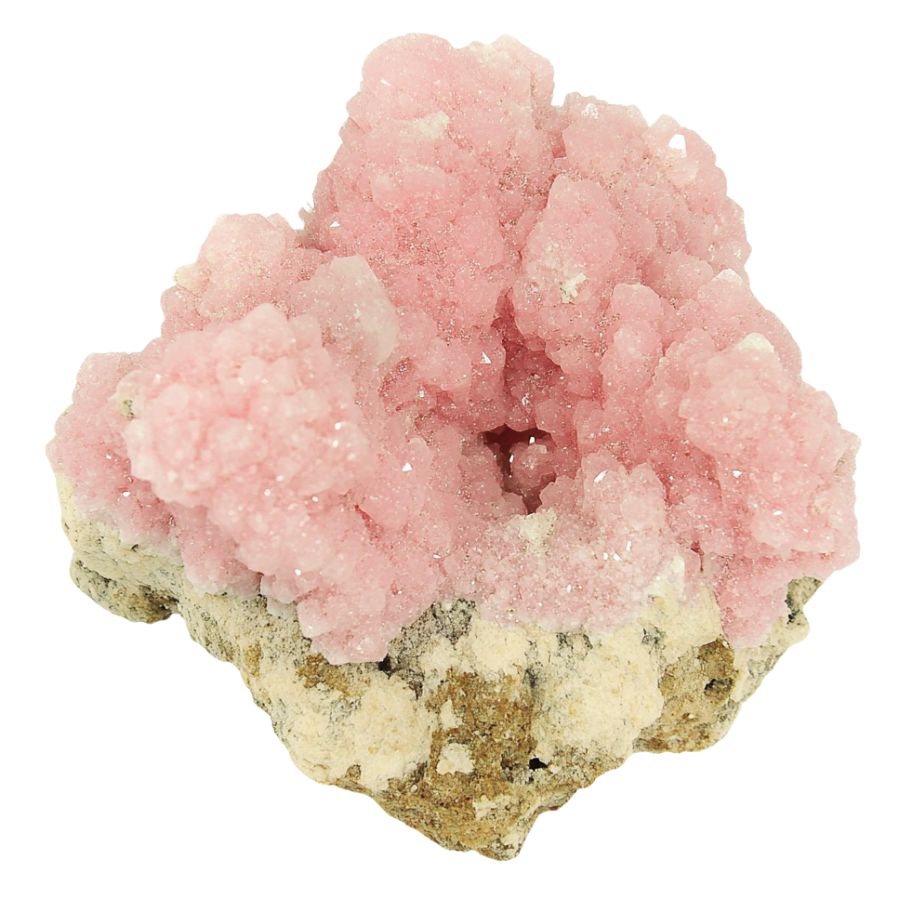
Peruvian Rhodochrosite exhibits a unique blend of pink tones with distinctive crystalline qualities. These stones often develop with exceptional clarity and a glass-like shine.
Crystal formation in these specimens tends to create angular patterns rather than rounded bands. This geometric growth pattern results in fascinating internal architectures that catch and reflect light in unique ways.
The combination of clarity and internal patterns makes these stones particularly fascinating under magnification. Collectors can observe minute details of crystal growth and formation that provide insights into the stone’s development process.
What Rough Rhodochrosite Look Like?
Rhodochrosite in its rough form can be tricky to spot, but once you know what to look for, it’s quite distinctive. Here’s how to recognize Rhodochrosite in its natural state.
Look for the Signature Pink-to-Red Color Range
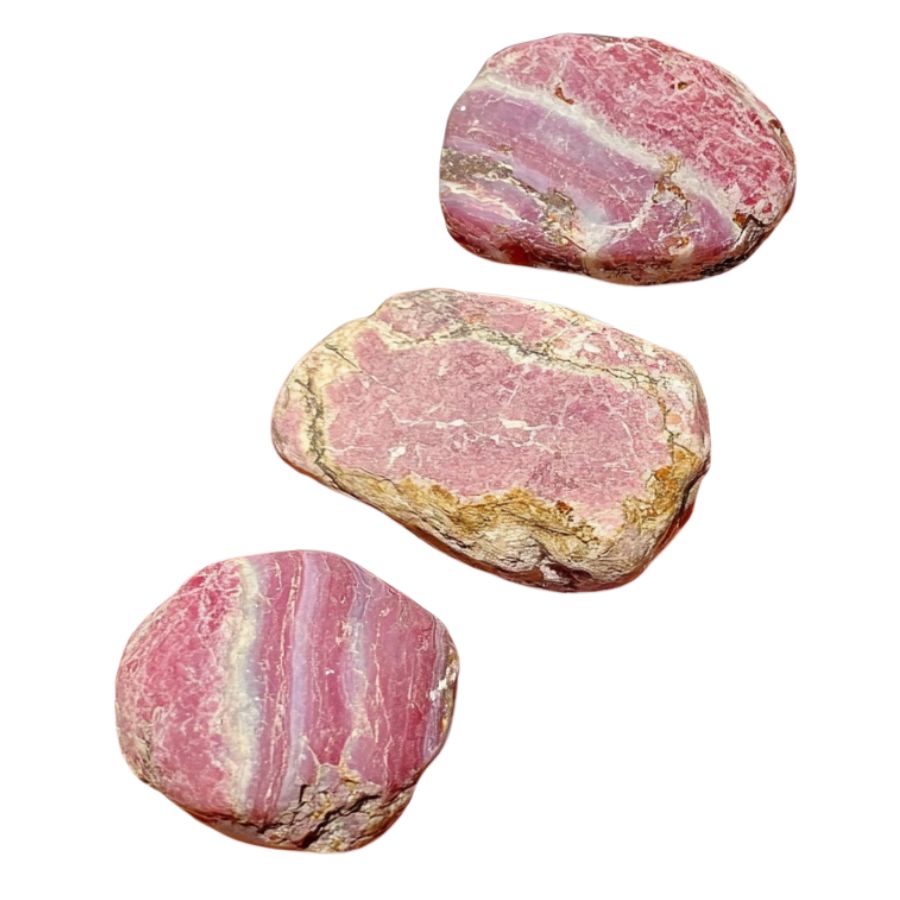
The most obvious telltale sign is its color – typically a warm, rosy pink to deep red. But here’s the thing: it’s not just one solid color. You’ll often spot subtle bands or zones of different pink shades.
Sometimes, you might see hints of brown or even light orange. Don’t dismiss it if it’s not perfectly pink – natural rhodochrosite can be surprisingly varied. The deeper, more saturated reds usually indicate higher-quality specimens.
Check for the Distinctive Crystal Structure
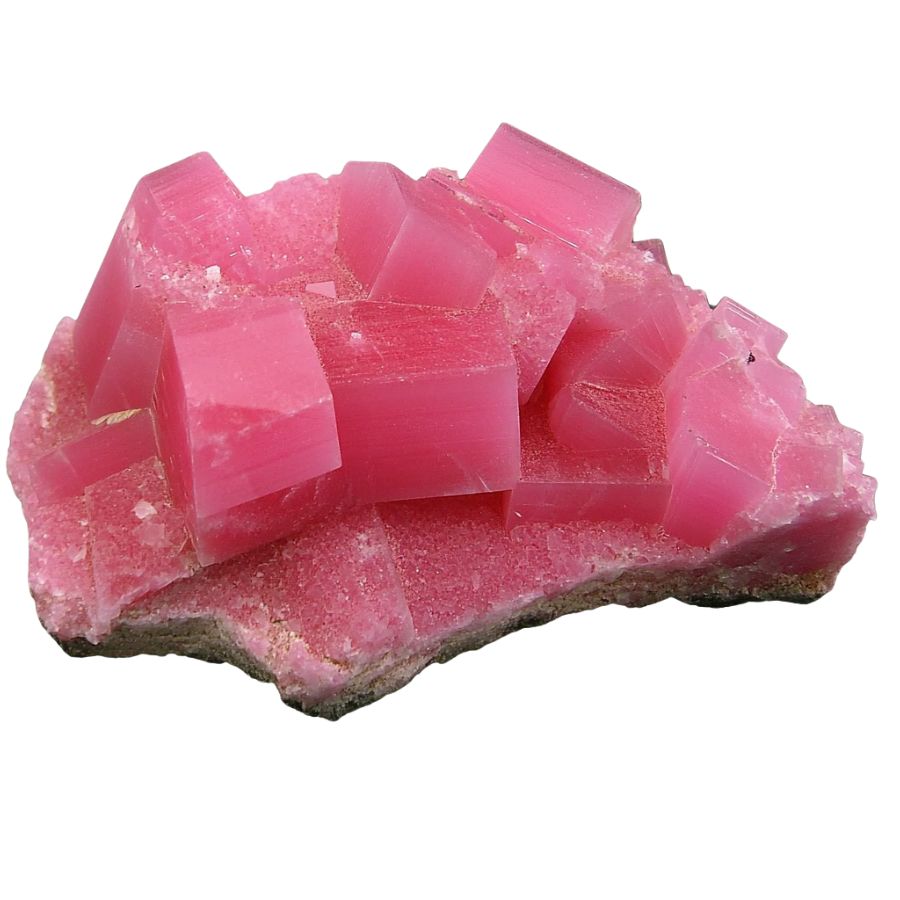
Unlike many minerals, rough rhodochrosite often forms in rhombohedral crystals. Look for angular edges and faces that meet at about 73 degrees. Sometimes you’ll find it in curved, saddle-shaped crystals (super unique!).
The crystals can be transparent to translucent, and they might appear in clusters or as individual specimens.
Examine the Surface Texture and Patterns
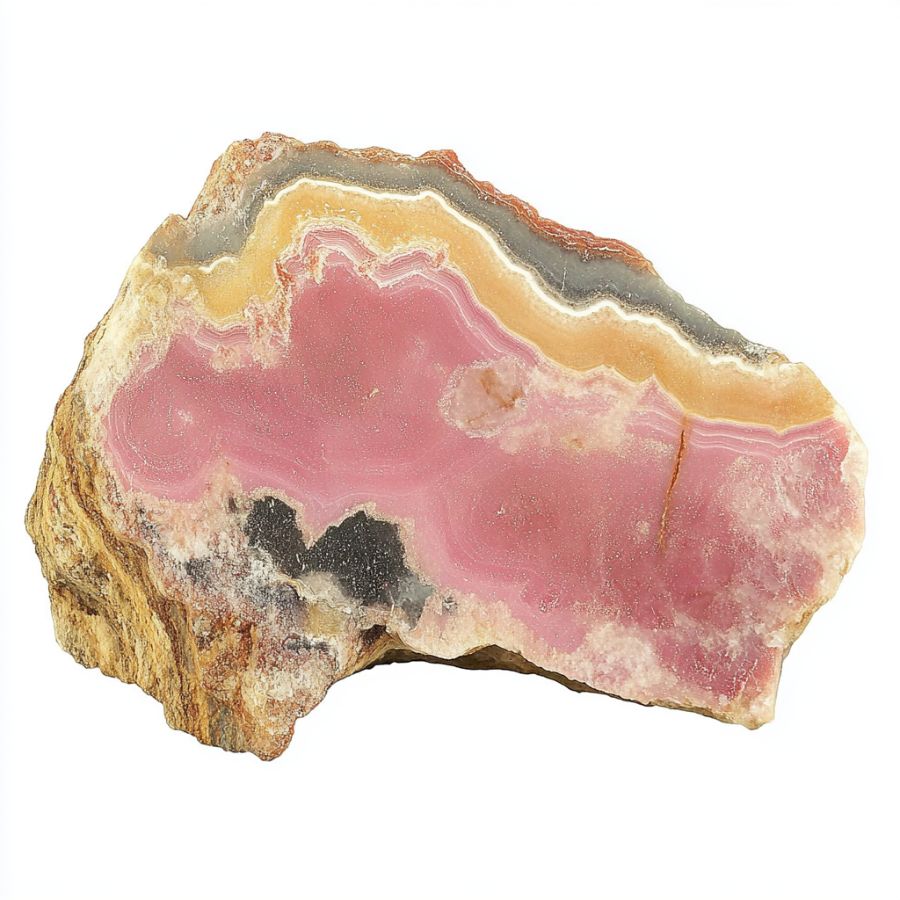
Run your fingers over the surface – rhodochrosite typically has a pearly to vitreous (glass-like) luster. Fresh breaks will show this best.
You might notice concentric banding patterns, especially in massive specimens. These bands often alternate between lighter and darker shades of pink. The surface might feel slightly smooth but not quite as glassy as quartz.
Test the Hardness and Fragility
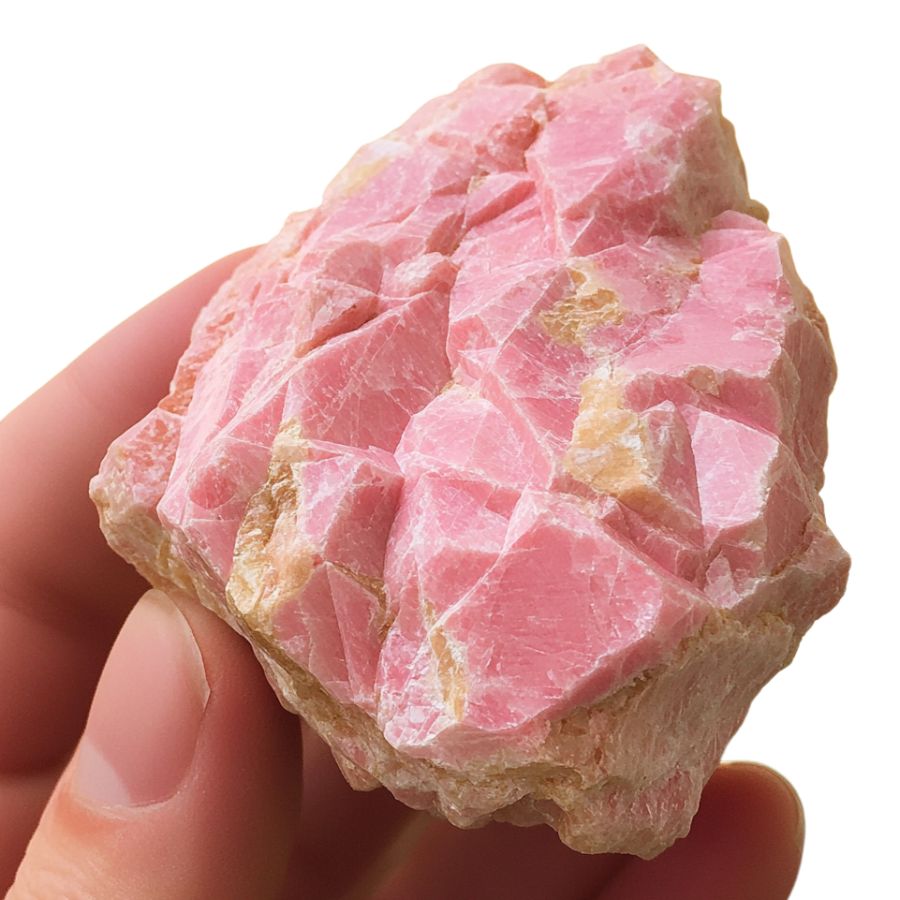
Here’s a crucial tip: rhodochrosite is relatively soft (3.5-4 on the Mohs scale). Try scratching it gently with a copper penny – if it scratches easily, you might have rhodochrosite.
Be gentle though! It’s pretty delicate and can break along cleavage planes. This softness and brittleness help distinguish it from similar-looking minerals like rose quartz, which is much harder.
A Quick Request About Collecting
Always Confirm Access and Collection Rules!
Before heading out to any of the locations on our list you need to confirm access requirements and collection rules for both public and private locations directly with the location. We haven’t personally verified every location and the access requirements and collection rules often change without notice.
Many of the locations we mention will not allow collecting but are still great places for those who love to find beautiful rocks and minerals in the wild without keeping them. We also can’t guarantee you will find anything in these locations since they are constantly changing.
Always get updated information directly from the source ahead of time to ensure responsible rockhounding. If you want even more current options it’s always a good idea to contact local rock and mineral clubs and groups
Tips on Where to Look
Rhodochrosite is a pink to rose-red mineral that often forms in veins and cavities. Here’s where you can typically find this beautiful stone while rockhounding in accessible locations across the US.
Abandoned Mine Areas
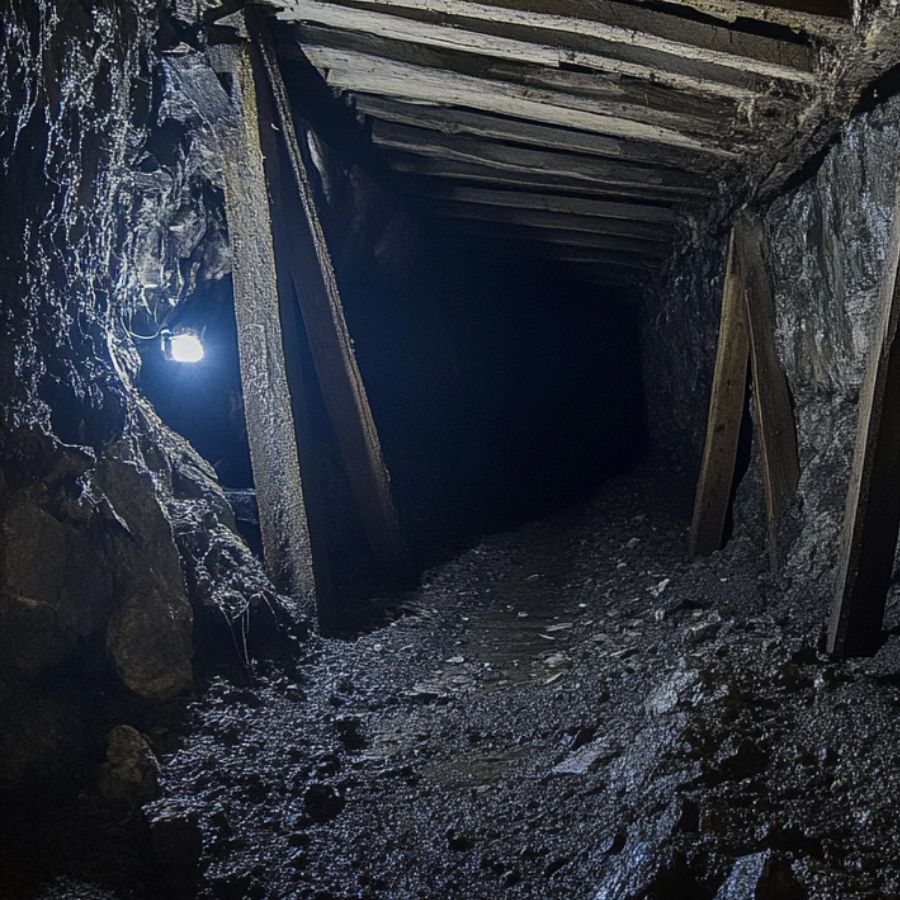
Old mines are great spots to find rhodochrosite. Check the mine dumps and tailings piles where miners discarded unwanted material. These areas often contain smaller pieces that weren’t commercially valuable but are perfect for collectors.
Look for pink-colored rocks in manganese-rich waste piles. The stone frequently appears alongside black manganese minerals, which can serve as a helpful indicator when searching.
Sometimes, you might get lucky and find specimens with beautiful banding patterns that were overlooked during mining operations.
Sedimentary Rock Formations
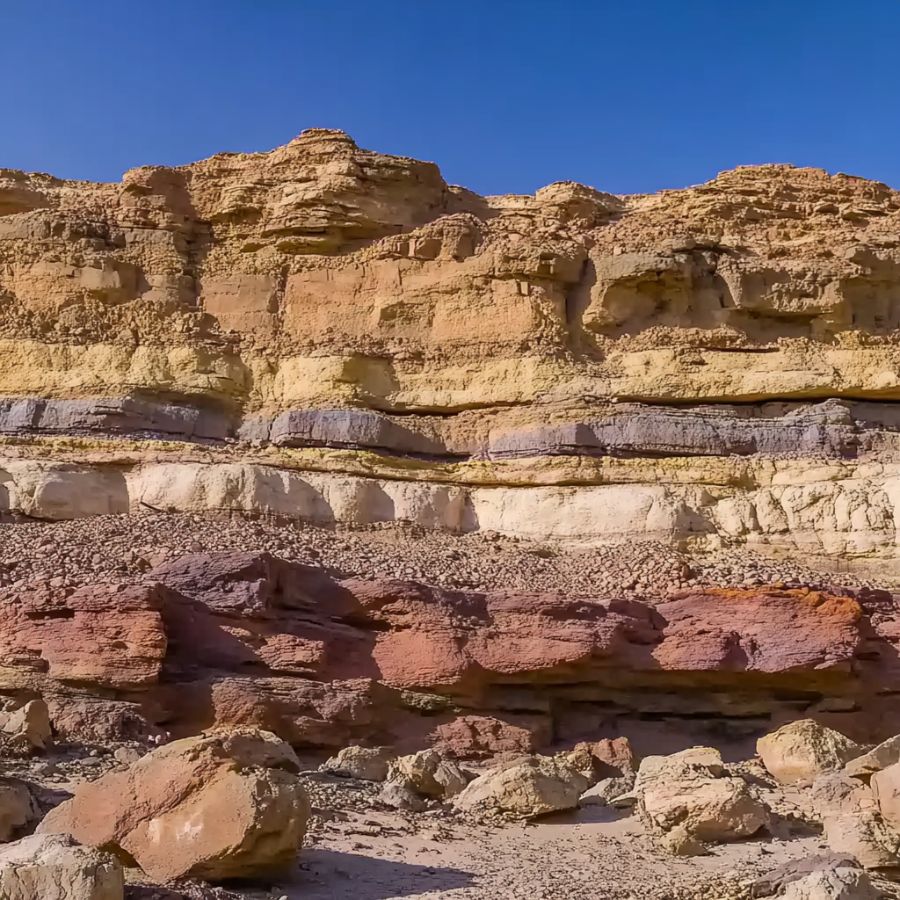
Many sedimentary rocks, especially those containing lots of manganese and calcium carbonate, can host rhodochrosite. Look for areas where limestone and dolomite are common. The stone often forms in the cracks and spaces between these rocks.
While exploring these formations, pay special attention to areas where water has carved out natural exposures, as these spots might reveal hidden rhodochrosite deposits that have been naturally weathered out over time.
Mountain Stream Beds
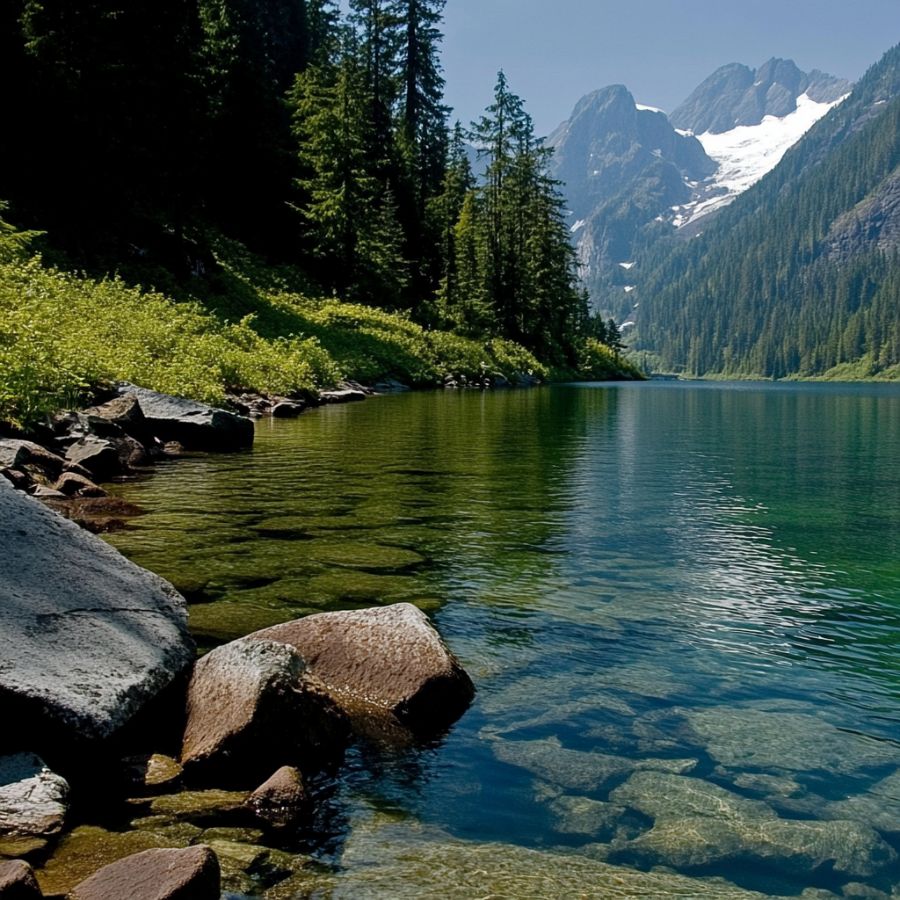
Stream beds in mountainous regions are excellent places to search. Focus on areas where the water has cut through manganese-rich rock formations, as the stream’s natural tumbling action often exposes and smooths rhodochrosite pieces.
During your search, concentrate on spots where the water slows down and creates natural collection points, such as behind large boulders or in quiet pools, because these areas tend to accumulate heavier minerals including rhodochrosite fragments that have broken free from their original source.
Some Great Places To Start
Here are some of the better places in the state to start looking for Rhodochrosite:
Always Confirm Access and Collection Rules!
Before heading out to any of the locations on our list you need to confirm access requirements and collection rules for both public and private locations directly with the location. We haven’t personally verified every location and the access requirements and collection rules often change without notice.
Many of the locations we mention will not allow collecting but are still great places for those who love to find beautiful rocks and minerals in the wild without keeping them. We also can’t guarantee you will find anything in these locations since they are constantly changing.
Always get updated information directly from the source ahead of time to ensure responsible rockhounding. If you want even more current options it’s always a good idea to contact local rock and mineral clubs and groups
Franklin Mine

Franklin Mine is in Franklin, Sussex County. This mine is famous around the world for having more than 360 different minerals in one small area. The Franklin Mineral Museum now shows off these special rocks. Miners used to dig up zinc, iron, and manganese here.
What makes this place amazing is that about 90 of these minerals glow under ultraviolet light! This happens because the area went through intense heat and pressure long ago, creating rare minerals.
Rhodochrosite can be found here as solid chunks and small crystals. Look for it in carbonate veins that cut through the main ore bodies. These pink minerals often appear with other minerals like willemite, dolomite, and serpentine.
Focus on these carbonate-rich areas for the best chance to find good samples. The mine also has several minerals that aren’t found anywhere else on Earth.
Pompton River
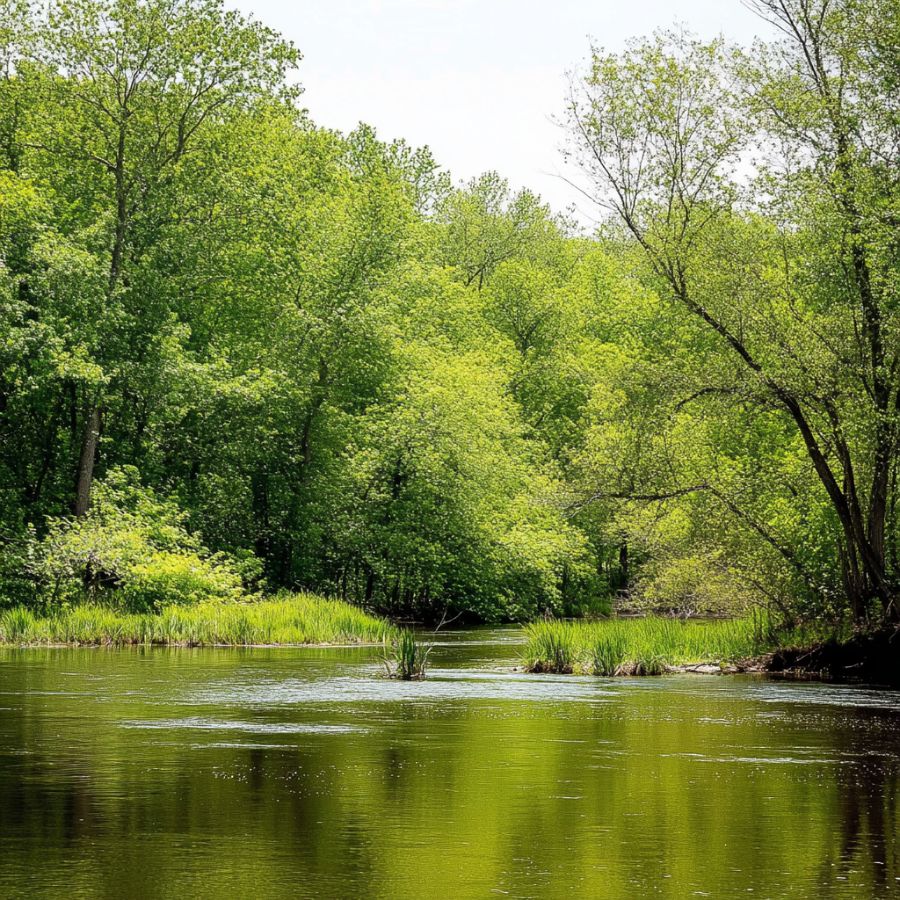
Pompton River flows for 8 miles through Passaic County in northern New Jersey. This river starts where the Ramapo and Pequannock rivers meet south of Pompton Lakes. It runs between several towns, including Lincoln Park, Pequannock Township, and Wayne.
The area around the river has interesting rocks from the Triassic and Jurassic periods. These rocks form what geologists call the Newark Basin. The river cuts through reddish-brown shale, siltstone, and mudstone of the Passaic Formation. These rocks formed in ancient shallow lakes and dry plains.
Check where different rock types meet, especially where hot water once flowed through cracks in the rocks. Old quarries near the river might expose mineral-rich veins.
The river environment has created conditions where manganese minerals like rhodochrosite could form over millions of years.
Sterling Mine

Sterling Mine sits in Ogdensburg, Sussex County. Today it operates as the Sterling Hill Mining Museum.
People began mining here as far back as 1739, first looking for iron and copper. Later, zinc became the main metal mined until the site closed in 1986. The tunnels reach 2,675 feet and stretch for 35 miles underground!
The mine’s rocks are about 1.3 billion years old, part of what geologists call the Franklin Marble. Rhodochrosite can be found here alongside other manganese minerals. One helpful tip is to look in areas where the mineral sarkinite has been found, as these two minerals often form together.
The museum allows visitors to see these amazing minerals and learn about the site’s history. Many rock collectors visit Sterling Hill hoping to add a piece of its famous minerals to their collection.
Bedminster Township
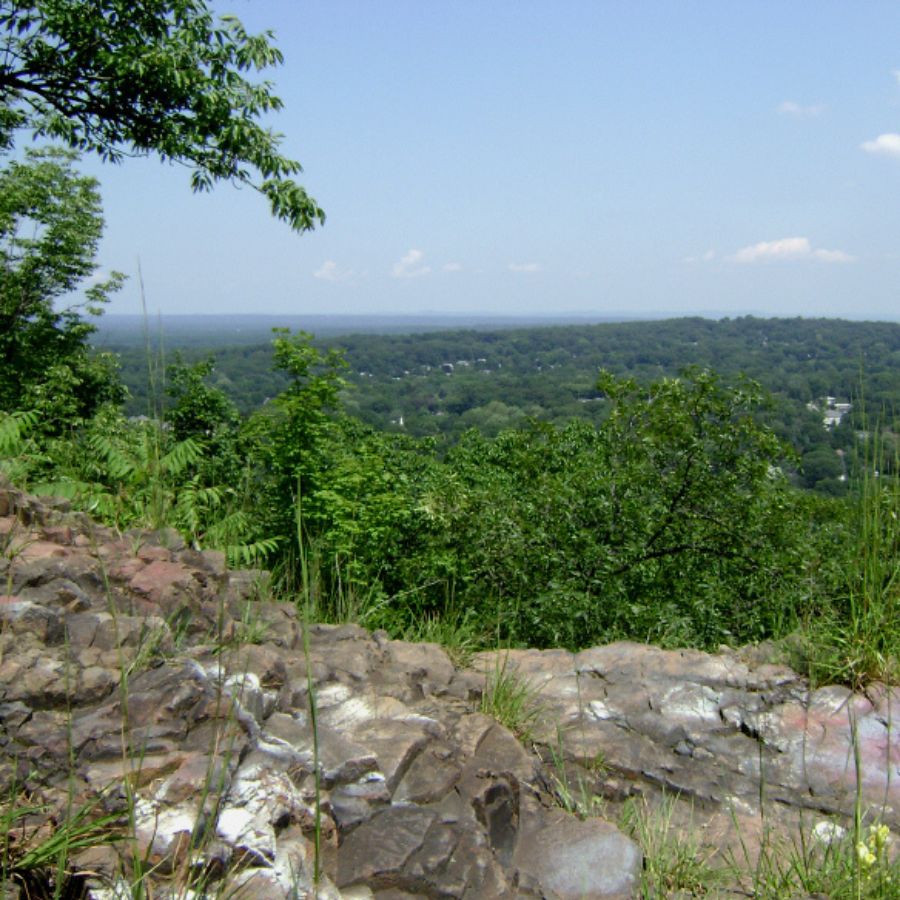
Bedminster Township lies in Somerset County. This area includes smaller communities like Pluckemin, Bedminster, and Lamington. The township sits within the Raritan Valley region as part of the Somerset Hills.
Nearby, you can see the Watchung Mountains, three long ridges made from ancient volcanic eruptions. These eruptions happened around 200 million years ago and created basalt rock formations.
Rhodochrosite appears in specific places within the township. The Pluckemin area has recorded findings of this rose-red mineral.
The unique geology of Bedminster, with its mix of sedimentary rocks and volcanic materials, creates good conditions for mineral formation. The area’s rich history of geological activity makes it an interesting spot for mineral collectors.
Limecrest Quarry

Limecrest Quarry is located in Sparta Township, Sussex County. This quarry has been around since 1895 and was once run by famous inventor Thomas Edison. For many years, workers have dug marble and minerals from this site.
The quarry sits in the Franklin Marble formation, which is known for its many rare minerals. Rock collectors often find interesting minerals here like norbergite, chondrodite, and graphite.
Rhodochrosite shows up in this quarry inside the marble rock. It typically forms within calcite veins that cut through the quarry. People looking for rhodochrosite should check where these white calcite veins run through the marble.
Another good sign is spots with brown or black manganese staining on the rock surface. These stains often mean rhodochrosite might be nearby. The quarry’s special mix of minerals and its long history make it a favorite spot for serious mineral collectors in New Jersey.
Places Rhodochrosite has been found by County
After discussing our top picks, we wanted to discuss the other places on our list. Below is a list of the additional locations along with a breakdown of each place by county.
| County | Location |
| Union | Houdaille Quarry |
| Somerset | Chimney Rock Quarry |
| Monmouth | Marlboro Township |
| Passaic | New Street Quarry |
| Bergen | The Palisades |
| Mercer | Pennington Mountain |
| Monmouth | Manasquan Beach |
| Morris | Stirling |
| Monmouth | Big Brook Preserve |
| Passaic | Paterson Great Falls |
| Cape May | Higbee Beach |
| Bergen | Ramapo Mountains |
| Warren | Pohatcong Mountain |
| Hunterdon | Musconetcong River |

